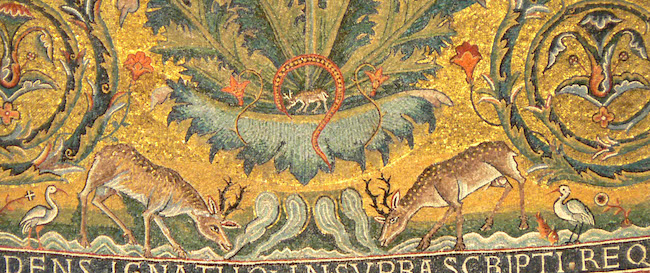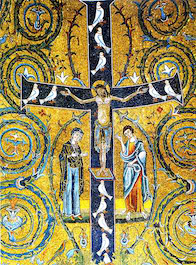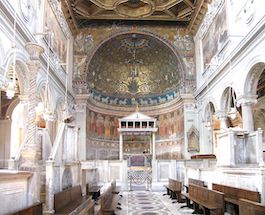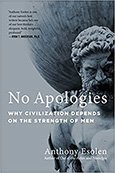Jewels for the Lord
- ANTHONY ESOLEN
A man lies back against a wooden cradle, high in the apse of the ancient church of Saint Clement in Rome.
Join the worldwide Magnificat family by subscribing now: Your prayer life will never be the same!

Before him stands the scooped-out round of a half-dome. Most of it is bare plaster. It's marked in rough strokes of black paint, a welter of shapes, hard to identify, except for the cross in the center, which is beginning to take form and color by his sure hand and keen eye.
"Master," says a boy, sitting upon the scaffolding, "why is heaven made of gold, when the sky is blue?"
The master takes from him a small gold tile, less than an inch square. He smiles a little but does not take his eye from the cross.
"Not this one," he says. "A little brighter, more yellow and less red." The boy scans a floor of tiles spread out before him, one by one, according to color and brilliance — gold and red, rich green and blue, pale pink and white. They are marble, jasper, garnet, lapis, onyx, and glass, and some of the tiles are overlaid with gold leaf beaten as thin as air. He picks out one that seems to shine with its own light.
"Excellent," says the master, fixing it in the plaster, right up against the dark wood of the cross.
"In a hundred years, son, what will happen to the gold?"
"Nothing," says the boy. "Gold doesn't rust."
"In a thousand years?"
"Nothing."
"That's why we use gold for heaven. It's filled with light, and it will never pass away."
The boy falls silent. Patience is all. His master is kind, and won't forget to teach him the art. His own fingers will soon be pressing gold tiles into the skies that show forth the cross, while the master works the subtle colors for Jesus and Mary and John. And the master will let him work on one of the smaller figures, a branch, a leaf, perhaps one of the birds — a peacock, maybe!
Living stones
Christians didn't invent mosaics. You can find them wherever you find colored stones. If you go to Pompeii, you can see somebody's mosaic for the pavement of his house. It's of a snarling black brute, and it reads cave canem — Beware of the Dog. Go to an old Roman bath, and you'll see pavements with dolphins, friendly to man, and fish, and sea-gods and goddesses.
But the Church raised the mosaic to a height never attained before or since. I'm not talking about technical skill. The matter of the art raised up the material to the divine. We ourselves, says Saint Peter, are like living stones raised up to be a spiritual house. That's not by our effort, but by the work of Christ. He is the stone which the builders rejected that has become the cornerstone. Can stones come to life?
 Look at the great apse at Saint Clement. Nothing in art can compare to it. Your first impression is of a whole world of gold and green: everything ablaze with life. I can't describe it all; it would be like making a catalogue of the universe. A little will have to do.
Look at the great apse at Saint Clement. Nothing in art can compare to it. Your first impression is of a whole world of gold and green: everything ablaze with life. I can't describe it all; it would be like making a catalogue of the universe. A little will have to do.
Jesus is in the center, upon the cross, which is now the tree of life. Twelve doves, the Apostles, move along the beams. Mary and John stand below, one on each side. But the cross has taken root! Its base has blossomed into an acanthus bush, symbol of immortality. You can see the acanthus on the capital of any Corinthian column. Here the scheme of glory is reversed: the cross is the column, its base is the acanthus, and it brings life back to a world given over to sin and death.
And what happens to the bush? It bursts forth into glory, and is not consumed or even contained. "I am the vine, you are the branches," said Jesus, and sure enough the branches of the tree of life cover the dome with their lush and complicated triple curls. They bear fruit, too: the fruit of holiness, of saints, of the New Jerusalem.
Are we there too, ordinary people? Yes, we are. Here are a couple of men with sheep and goats. Here's a peasant woman feeding her chicks, with a delightfully gaudy rooster looking on. Peacocks, lilies, roses, baskets of fruit, even a naked cherub riding a happy dolphin.
Living water
Most of the time you'll see the blood of Christ flowing down the cross to bring life to the earth beneath, with a skull at the base, for Golgotha, but also for death: it is Adam's skull, man's skull.
"Can these bones live?" said God to the Prophet Ezekiel in the valley of the dry bones. Yes, they can, in Christ. So the artist at Saint Clement shows a flood of water gushing forth from the base of the cross: the four rivers of paradise. The second Adam has flung open the gates of a new Eden.
"I will give you living water," said Jesus to the woman at the well. Living water is not stagnant but rushing; not brackish but fresh. It is new water — ever new. Who longs for such water? We all do. So the artist has portrayed deer drinking from the water, careless of the tail of the dead serpent nearby. "As the deer longs for flowing streams," says the Psalmist, "so longs my soul for you, O God."
Blue becomes the dominant color there, a rich blue and white. That is not only for the water we need for our lives here and now. The artist is always thinking of eternity. He is thinking of the vision of Saint John, and the river of the water of life, that flows from the side of the throne of God and the Lamb, with the tree of life on either side. We are made to thirst for that water.
We thirst for the sight of God, the living God. Only such a thirst can raise the mind and heart of man beyond himself. And only a vision of the whole of life, from its beginning when God commanded the light into being, to its end and beyond, in the new heaven and new earth, can have animated all of those artists whose names we do not know, to fashion works that otherwise man can never accomplish, because he never conceives them in the first place.
"Another gold, my boy," says the master.
Never like this
"Master," says the boy, knitting his brows, "what do the words mean?" He can serve at the altar, so he knows some Latin, but he isn't sure of these. It's a big inscription, running along the base of the dome."Ah, the bishop himself composed those."
"Composed?"
"Verses, my boy. Poetry. I'm not very good at it, but let me give it a try." He reads it out, keeping the syllables distinct and putting the accents where they belong:

EC-cle-si-AM CHRIS-TI VI-TI si-mi-LA-bi-mus IS-TI:
DE LIG-NO CRU-CIS, Ja-co-BI DENS, IG-na-ti-I-QUE
IN-SUP-RA SCRIP-TI re-qui-ES-CANT COR-po-re CHRIS-TI,
QUAM LEX A-REN-TEM, SED CRUX fa-cit ES-se vi-REN-TEM.
The boy's eyes grow wide. He guesses a little, but the rest is a mystery. "It means this," says the master. "We have likened the Church of Christ to this vine, which the Law made withered and dry, but the cross has caused to be green with life again. That's the first and last lines. The ones in the middle say that we've placed some wood of the cross under the body of Christ here, along with a tooth from Saint James and Saint Ignatius."
"Teeth!"
"Sure, right underneath these tiles, here and here."
"Like hidden treasure," says the boy. "But what kind of poetry is that?" he says, trying to count the syllables.
"Very old, very old. I can't tell how old. Pagans made it."
"They didn't believe in Jesus."
"No, they didn't."
"But we use their poetry."
"We use their roads, don't we? And they did this too," says the master, motioning toward the tiles.
The boy surveys the colors again. Light from the window strikes them and makes them glimmer as if alive.
"But not like this," says the boy.
"Never like this."
Light everlasting
They express, better than any other form of art, both the solid weightiness of the faith and its light-bearing power.
If you look at the top of the dome at Saint Clement, you will see Christ the Ruler of the world, with symbols of the Evangelists to his left and right. His hand is raised in blessing, with two fingers extended, for he is true Man and true God, both. Below him is a medallion bearing the Chi-Rho symbol for his name, and the Alpha and the Omega, for he is the one who is and who was and who is to come, the first and the last, the Almighty.
You can find mosaics all over the Christian world, from the Caucasus mountains in the east to Portugal in the west, and then on to the New World. They express, better than any other form of art, both the solid weightiness of the faith and its light-bearing power. It is as if light itself had heft: blocks of light, pillars of light, arches and domes of light.
If you say, "We can still have mosaics without the Church," you'd be right, but what would be the point of it? We have gold still, but without the Church, without faith in Christ, to what would we apply that gold?
Let us then strive to see as that master of Saint Clement did, long ago. For he saw not by his own light, but by Christ, the light of the world.
 This is Meaghen Gonzalez, Editor of CERC. I hope you appreciated this piece. We curate these articles especially for believers like you.
This is Meaghen Gonzalez, Editor of CERC. I hope you appreciated this piece. We curate these articles especially for believers like you.
Please show your appreciation by making a $3 donation. CERC is entirely reader supported.

Acknowledgement
 Anthony Esolen. "How the Church Has Changed the World: Jewels for the Lord." Magnificat (June, 2020).
Anthony Esolen. "How the Church Has Changed the World: Jewels for the Lord." Magnificat (June, 2020).
Join the worldwide Magnificat family by subscribing now: Your prayer life will never be the same!
To read Professor Esolen's work each month in Magnificat, along with daily Mass texts, other fine essays, art commentaries, meditations, and daily prayers inspired by the Liturgy of the Hours, visit www.magnificat.com to subscribe or to request a complimentary copy.
The Author

Anthony Esolen is writer-in-residence at Magdalen College of the Liberal Arts and serves on the Catholic Resource Education Center's advisory board. His newest book is "No Apologies: Why Civilization Depends on the Strength of Men." You can read his new Substack magazine at Word and Song, which in addition to free content will have podcasts and poetry readings for subscribers.
Copyright © 2020 Magnificat



